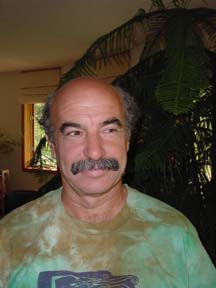The Black Mesa OK CBC Jan 1 06
(Officially listed as Kenton, OK)
I spent the day mostly with John Sterling, who is listed as the number one Oklahoma birder in the ABA list report. He knew every nook and cranny of our territory, and the names of most of the folks living there. And a lot of the local history, some of which he pointed out as we wandered around. Including the two versions of the Kansas/Texas/Oklahoma state line corner marker. No GPS in those days. The habitat was mostly dry canyon country, but at one point we got up pretty high, serious back-of-beyond barely passable ranch road climbing. You'd have to call the whole circle blacktop remote, certainly no cell phone, but switching on a radio got nothing but spinning numbers as it searched the whole dial over and over. It was unforgettable, some of the most enchanting birding I've ever done. Started the morning by calling up a Western Screech Owl with a CD playing in the dark. First bird of the year, and a good one. My nemesis bird was the Junper Titmouse, John's was Lewis's Woodpecker. Couldn't find them. We met up for the count summary in a motel room way far east of the circle, after chowing down at the Pizza Hut, only place open. Don't let the short list fool you, this was a great day birding in the middle of nowhere, and I had stopped two days earlier and found a Northern Shrike and a Townsend's Solitaire at Black Mesa State Park.
Western Screech-Owl
Great Horned Owl
Western Scrub-Jay
Mallard
Eurasian Collared-Dove
Northern Flicker
Mountain Bluebird gazillions
European Starling
American Robin
Eastern Bluebird
Canyon Wren
Red-winged Blackbird
American Goldfinch
Sage Thrasher best bird, in the high lonesome place
Red-bellied Woodpecker
Say's Phoebe
Yellow-bellied Sapsucker
Common Raven
Chihuahuan Raven
Spotted Towhee
Canyon Towhee
Bald Eagle flying with
Golden Eagle
Black-billed Magpie
It seems like there were others but for some reason they're not coming out on the report.
Some things John caught and I didn't. He's a master birder and really familiar with the habitat and the critters. Something to strive for. Nevertheless, many of these were new tics for OK.
I spent the day mostly with John Sterling, who is listed as the number one Oklahoma birder in the ABA list report. He knew every nook and cranny of our territory, and the names of most of the folks living there. And a lot of the local history, some of which he pointed out as we wandered around. Including the two versions of the Kansas/Texas/Oklahoma state line corner marker. No GPS in those days. The habitat was mostly dry canyon country, but at one point we got up pretty high, serious back-of-beyond barely passable ranch road climbing. You'd have to call the whole circle blacktop remote, certainly no cell phone, but switching on a radio got nothing but spinning numbers as it searched the whole dial over and over. It was unforgettable, some of the most enchanting birding I've ever done. Started the morning by calling up a Western Screech Owl with a CD playing in the dark. First bird of the year, and a good one. My nemesis bird was the Junper Titmouse, John's was Lewis's Woodpecker. Couldn't find them. We met up for the count summary in a motel room way far east of the circle, after chowing down at the Pizza Hut, only place open. Don't let the short list fool you, this was a great day birding in the middle of nowhere, and I had stopped two days earlier and found a Northern Shrike and a Townsend's Solitaire at Black Mesa State Park.
Western Screech-Owl
Great Horned Owl
Western Scrub-Jay
Mallard
Eurasian Collared-Dove
Northern Flicker
Mountain Bluebird gazillions
European Starling
American Robin
Eastern Bluebird
Canyon Wren
Red-winged Blackbird
American Goldfinch
Sage Thrasher best bird, in the high lonesome place
Red-bellied Woodpecker
Say's Phoebe
Yellow-bellied Sapsucker
Common Raven
Chihuahuan Raven
Spotted Towhee
Canyon Towhee
Bald Eagle flying with
Golden Eagle
Black-billed Magpie
It seems like there were others but for some reason they're not coming out on the report.
Some things John caught and I didn't. He's a master birder and really familiar with the habitat and the critters. Something to strive for. Nevertheless, many of these were new tics for OK.

